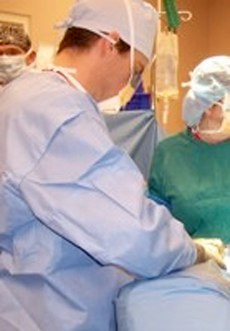Napa Valley Fertility Center offers a comprehensive range of reproductive surgical treatments. Inspired by the difficulties he encountered when trying to access a minimally-invasive surgical procedure for his son, Dr. Uzelac is committed to always making available to his patients the latest and most innovative techniques. We employ the following in our approach:
-
Laparoscopy
Telescope-like instruments are inserted through the abdominal wall which allow direct visualization and instrumentation of the pelvic organs.
-
Hysteroscopy
Equipment similar to laparoscopy but the surgical approach is vaginal and the evaluation focuses on the inside of the uterus (uterine cavity).
-
Robotic Surgery
A recent addition to our surgical armamentarium, the cutting-edge da Vinci Robotic-Assisted Surgical System.
indications
Some of the more common indications for reproductive surgery include:
-
Endometriosis
Endometriosis results when implants of menstrual tissue seed and grow in areas of the pelvic or abdominal cavities. Endometriosis interferes with many steps in the reproductive process and can be responsible for such things as poor egg quality and implantation failures. Surgery attempts to remove all of the visible disease and restore pelvic anatomy to its natural state.
-
Fibroids
Fibroids are spherical growths of muscle tissue originating from the uterus. They are extremely common, occurring in one out of three women by the end of their reproductive lifespan. Fibroids can vary dramatically in size and location and only under certain circumstances do they interfere with reproduction.
-
Ovarian Cysts
An ovarian cyst is a spherical fluid collection encased by a layer of tissue. Some cysts are physiologic and will resolve by themselves with time. Persistent or odd-appearing cysts can interfere with normal ovarian function, are occasionally a sign of a serious disease and are customarily evaluated by surgery.
-
Uterine Polyps
Polyps are finger-like projections of tissue that occur in many hollow organs throughout the body. In the uterus, a polyp creates an inflammatory environment, interfering with normal embryo implantation. Removal of uterine polyps is accomplished by hysteroscopy.
-
Uterine Anomalies
Roughly 3-4% of infertile women were born with an anatomic variation in the development of their uterus. The most common is known as a uterine septum whereby a plane of tissue divides a variable portion of the uterine cavity into two compartments. Embryo implantation and growth are affected and surgical therapy is accomplished via hysteroscopy.
Other surgical procedures in reproductive medicine involve assisted reproductive technologies (GIFT, ZIFT) and tubal reanastomosis (the reversal of a previous tubal sterilization procedure).
For more information about our reproductive surgery services, please contact us at 707.259.1955 or info@napavalleyfertility.com.


